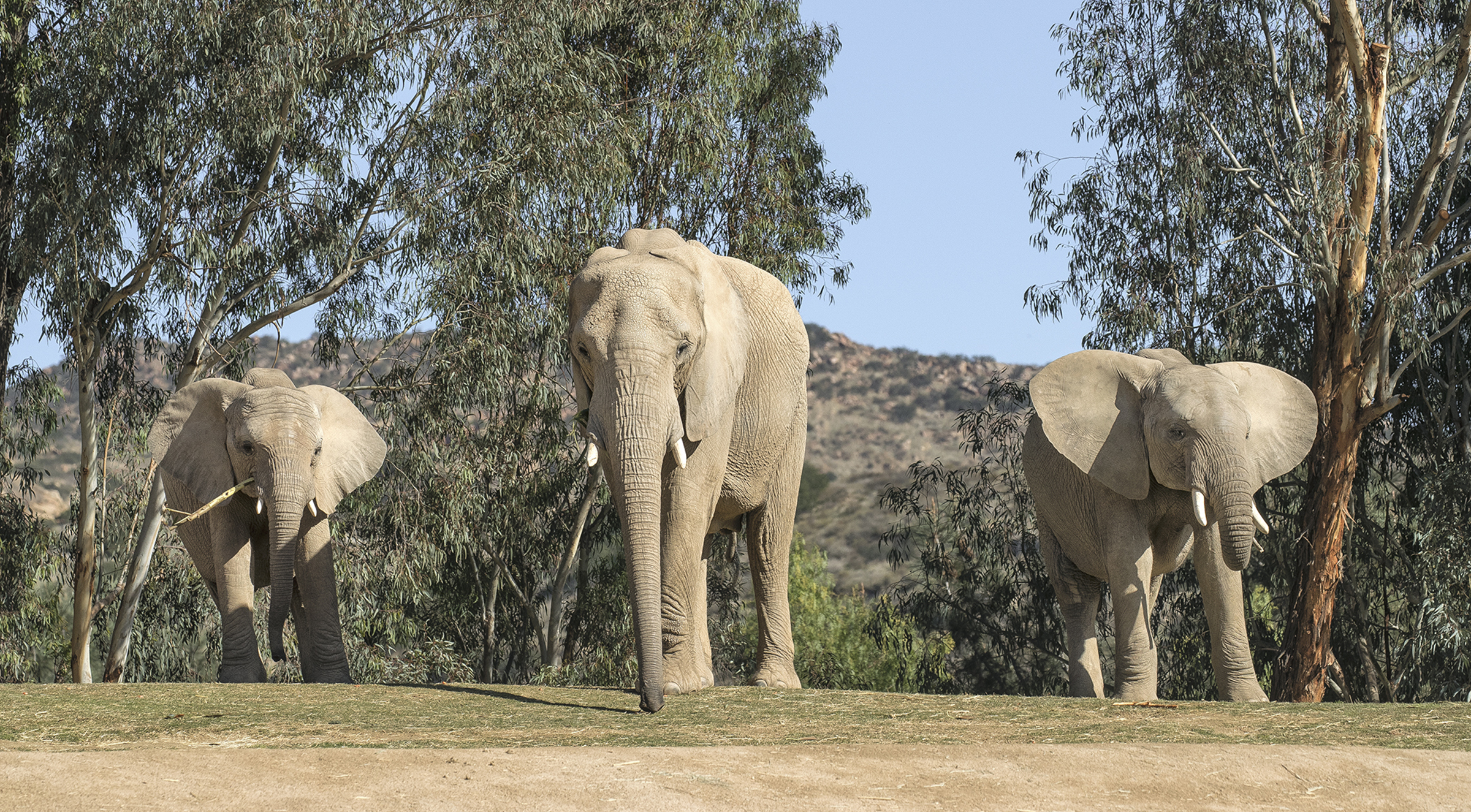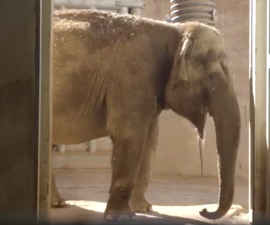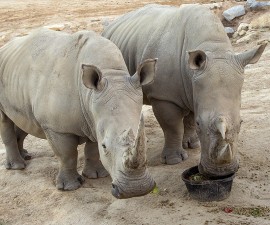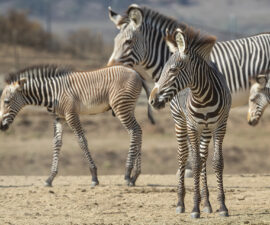With 12 African elephants—the largest herd in any Association of Zoos & Aquariums (AZA) facility—there’s always something happening at the Safari Park!
BY Donna Parham
Photography by Ken Bohn
Spend a bit of time at the Safari Park’s elephant viewing patio, and you are likely to run into a red-shirted volunteer like Eileen Jennings, who is here to share information and insights with Park visitors. She has spent hours observing the elephant herd, and has come to recognize the nuances of their behavior. “You might think the elephants are just standing around, minding their own business, but there’s so much going on, under the surface,” she says. “They’re all in tune with each other’s body language.” Certain elephants are large and in charge, while others are more submissive. And the youngsters are likely to test the limits of accepted elephant social behavior. Who knew that the elephant yard at the Safari Park had so much in common with any large family gathering? Let’s get to know the latest in this pachyderm Peyton Place.
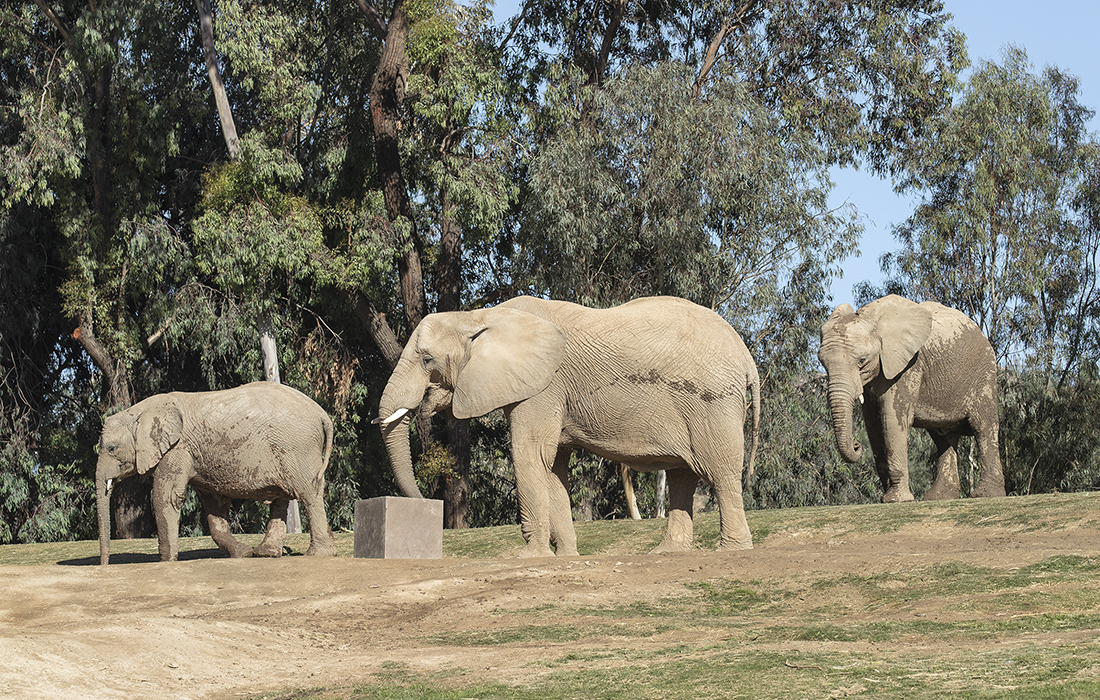
HER MAJESTY
Swazi (center) is the matriarch, and she doesn’t hesitate to let the rest of the herd, including 6-year-old Qinisa (left) and 11-year-old Phakamile, know it.
MAMA DRAMA
The leader of an elephant herd is always a female—the matriarch. At the Safari Park, that’s Swazi. The other two adult females, Umngani (OOM-gah-nee) and Ndula (en-DOO-luh, short for Ndulamitsi) defer to her. All their offspring are part of the herd, too—up to a point. While females usually stay with the same herd their entire lives, “A mom pushes her son out when he’s a teenager,” says Curtis Lehman, animal care supervisor. Sometimes, these young males are content to strike out on their own, but they often form bachelor herds, and that’s something that’s happening at the Safari Park, too.
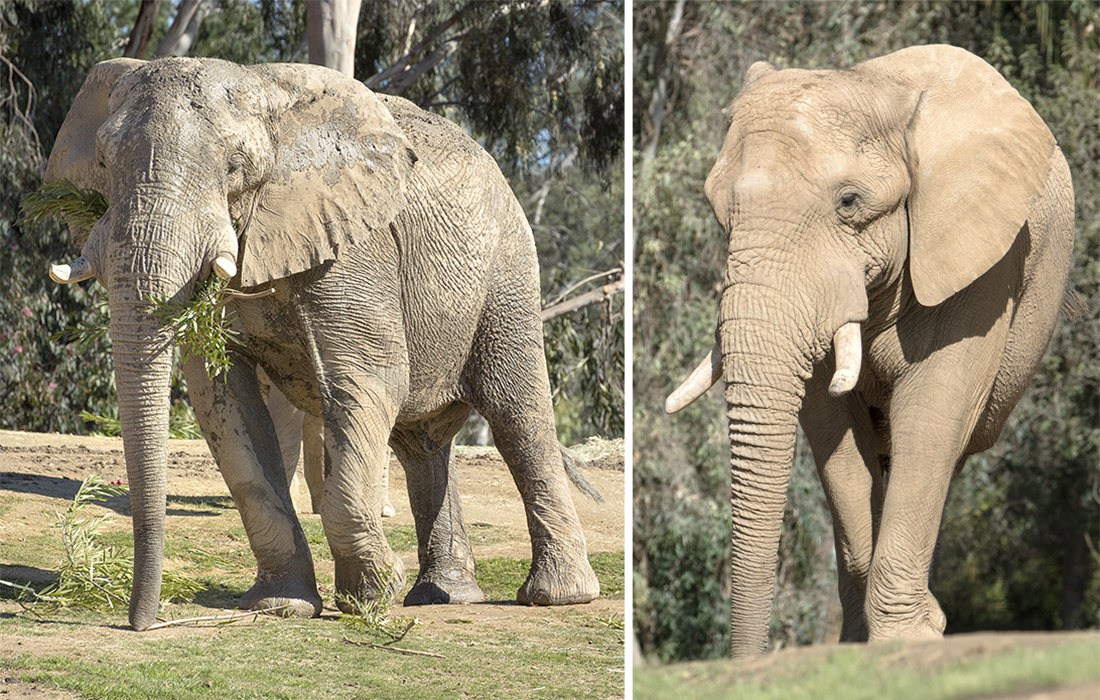
BULLISH
M’sholo (left) is the Safari Park’s adult bull elephant. Mabu (at right), who fathered all of the Safari Park elephant calves, recently moved to the Reid Park Zoo in Tucson, Arizona. While both elephants spent time with their herd-mates, they didn’t share space with each other.
MALE MUSCLE
Eventually, most older male elephants—usually the largest and most dominant—will breed with receptive females. In the wild, a dominant bull visits several herds in his territory, attempting to mate with as many females as possible. At the same time, he works hard to keep other males away.
Sometimes, two bulls face off: trumpeting, trunk wrestling, pushing, and tusking ensue, and while injuries are rare, they can be severe. So when bull elephants Mabu and M’sholo were both living at the Safari Park, they each had regular access to other elephants and the various expansive elephant yards, but they didn’t have physical access to each other. If they were together, Curtis says, “Eventually, they’d probably figure out who was dominant, and they might be just fine after that.” But he warns that with two 13,000-pound bull elephants, “There is the potential for harm, and it’s not worth the risk.”
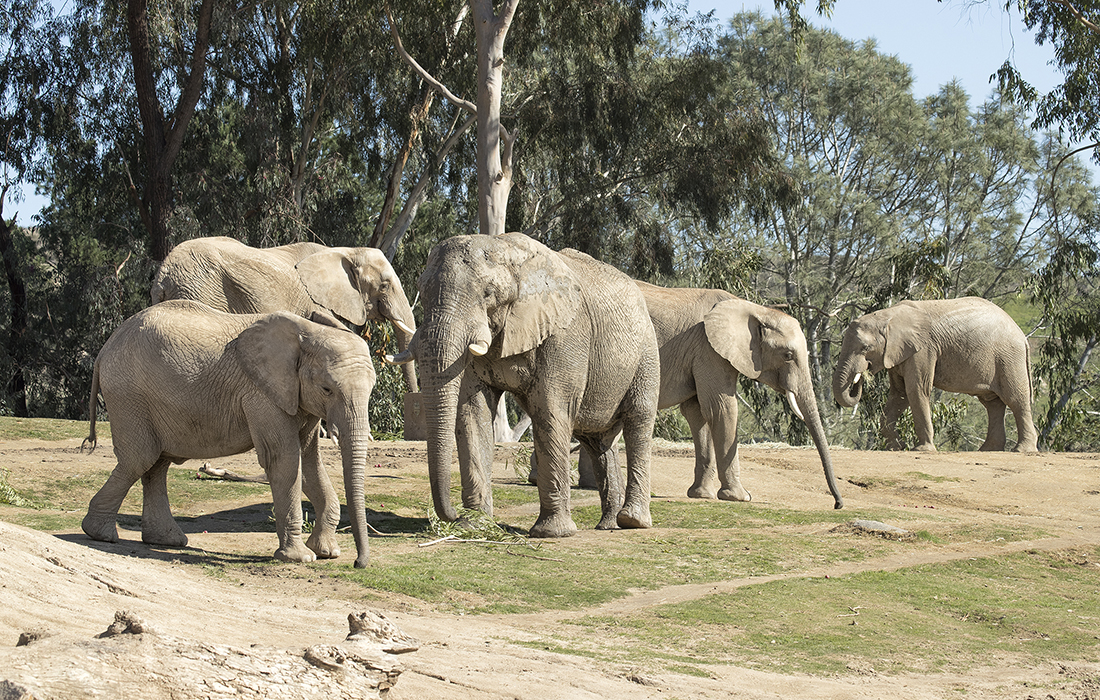
ROLE MODEL
Bull elephant M’sholo (second from left) socializes with the herd. Such interaction is particularly beneficial for subadult males like Ingadze (center) and Inlonipho (right).
 Click here to read more about the elephants rescued from a scheduled cull in Swaziland, and to see the elephants at the Safari Park in action!
Click here to read more about the elephants rescued from a scheduled cull in Swaziland, and to see the elephants at the Safari Park in action!
FAREWELL FOR NOW, MABU
Bull elephant Mabu has moved on, to Reid Park Zoo in Tucson, Arizona. In zoos, elephants are bred according to the recommendations of the AZA African Elephant Species Survival Plan (SSP). Based on these breeding recommendations, zoos send bull elephants—sometimes across the country—to female herds. This allows the herds to maintain their matriarchal social structure. For a bull like Mabu, on the other hand, moving in and out of different herds for breeding is typical, natural behavior.
In 2012, Mabu first traveled, with with 2 adult females and 2 of his 10 calves to Reid Park Zoo, to establish a herd there. He sired another daughter, Nandi, before returning to the Safari Park in 2016. While he was back, Mabu successfully bred with adult females Ndulamitsi and Umngani—so visitors (and Elephant Cam watchers) can expect the pitter patter of little(ish) elephant feet later in 2018. Ndulamitsi’s calf is due to arrive sometime in August or September, and Umngani’s calf should make its appearance in October or November.
While Mabu is now doing what bull elephants do best at the Reid Park Zoo, M’sholo, another bull, is at the Safari Park on loan from Lowry Park Zoo. Although he has yet to sire a calf, Safari Park elephant keepers “would keep him forever if it was up to us,” says Curtis. “He has great social interaction with the younger males.”
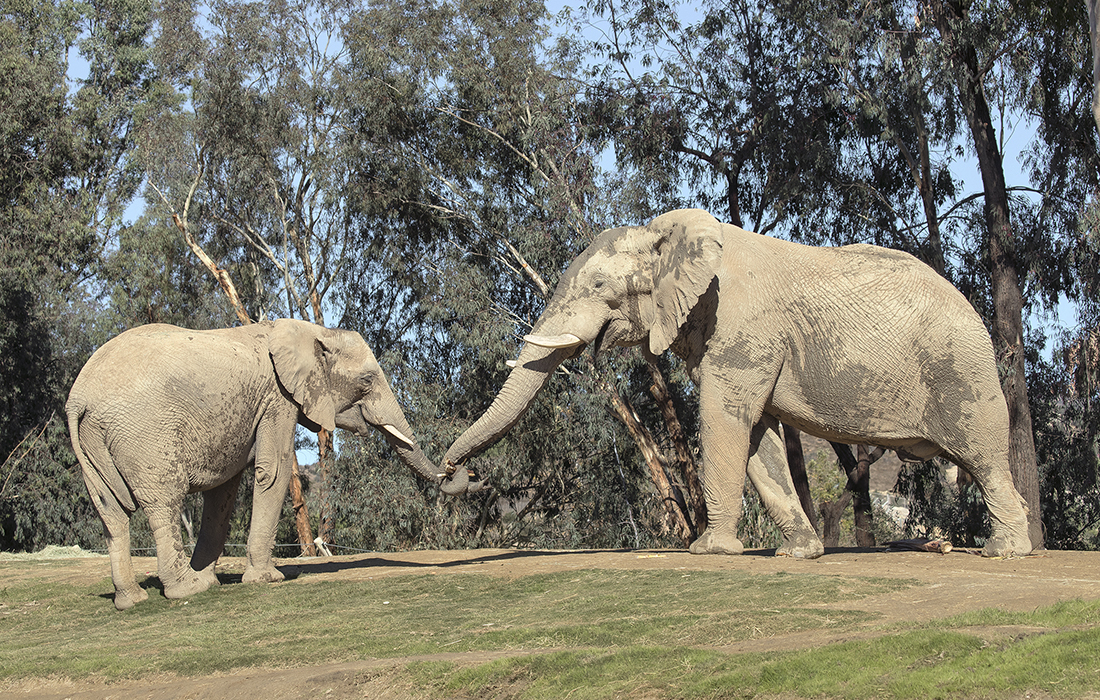
GROWING UP
Female Khosi (left) is becoming reproductively mature. Here she’s interacting with bull M’sholo.
GETTING TOGETHER
To keep elephants safe, it has been a common practice in zoos to keep bull elephants away from the rest of the herd except for breeding. But at the Safari Park’s spacious Elephant Valley, M’sholo wanders among the rest of the herd. “We had to be creative, space-wise, when Mabu was here, so that both bulls could socialize with the rest of the group—just not with each other,” says Curtis.
With Mabu on site, there were challenges. Mabu’s two oldest daughters, Khosi (KO-see), now 11, and Kami (KAM-ee, short for Phakamile), 10, complicated matters. Barbara Durrant, Ph.D., Henshaw endowed director of reproductive sciences at the San Diego Zoo Institute for Conservation Research, regularly examines urine hormone levels for each of the elephants. “Khosi has started cycling,” she says, indicating the spiked graph on her computer screen as evidence. And, she notes, Kami is not far behind, reproductively. So, keepers made sure to keep the two young females where they wouldn’t encounter their father Mabu.
Within these constraints, the keepers’ goal was to vary the yards where the elephants spend their time. Putting that into practice, though, sounds like a mind bender puzzle. “It was like playing a chess game every day, doing all these separations,” says Curtis. But “it was well worth the effort.” In fact, he credits the high-quality, complex social interactions he sees among the herd with keeping the elephants together as much as possible.
In particular, keepers note beneficial social development in male calves as they interact with bulls. “That’s a big plus for us, because the young males learn proper elephant behavior from their elders,” says Curtis.
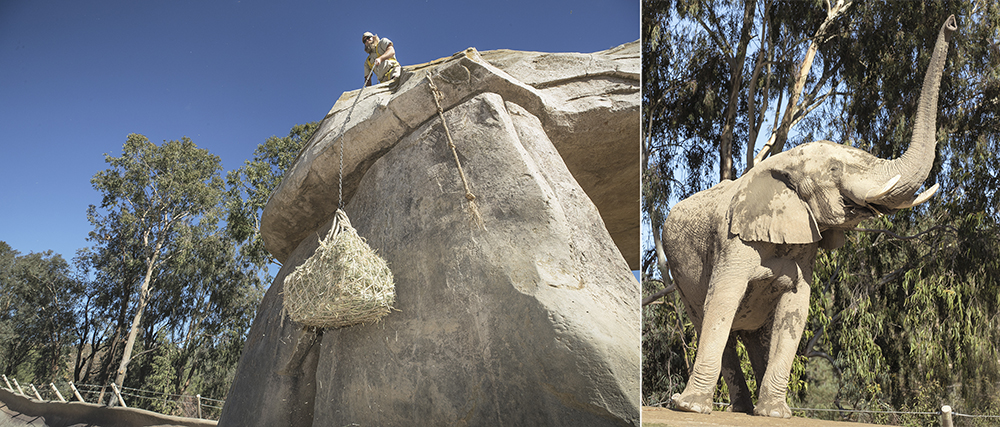
TALL ORDER
Keepers go to great lengths (and heights!) to keep the environment enriched for the elephants. Reaching for hay that’s held high in a net mimics the way elephants browse on leaves in the wild.
 The Elephant Cam (and the other remote cameras at the Zoo and Safari Park) are staffed thanks to our talented volunteers.
The Elephant Cam (and the other remote cameras at the Zoo and Safari Park) are staffed thanks to our talented volunteers.
SETTING THE SCENE
“You want to provide all the elephants with opportunities for social interaction and with inviting space,” says Curtis. The Safari Park’s elephant habitats spread out over six acres, divided into two main yards and some smaller holding areas, and Curtis notes that the herd has “excellent spatial interaction, as far as the full use of the land that’s available to them.”
The keepers can take at least part of the credit for that. They put an enormous effort toward enriching each exhibit space. “It’s a daily challenge, to create an enriching environment, so the elephants have plenty of things to do. We have to be creative,” says Curtis. Visitors (and cam watchers) can see evidence of this creativity. Elephants forage for food and treats in feeding cubes that they can access only with their trunk. And reaching for hay that’s held high in a net mimics the way they’d browse on leaves in the wild.
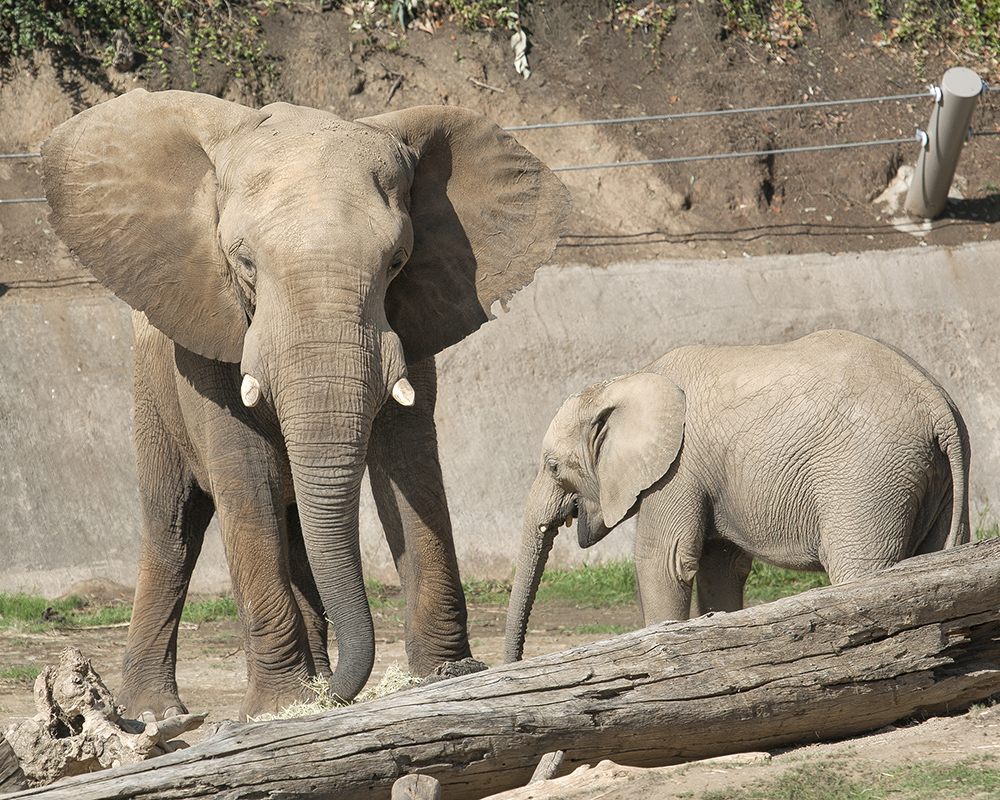
BOUNCING BABY BOY
Emanti (right) was born out in the main elephant yard, so he’s spent time socializing with bull M’sholo (left) all his life.
BABY BOOM
The way the elephant team manages the herd has paid off in big ways. “We’ve had a bumper crop of babies,” says Barbara. The baby boom started in 2004, when Ndulamitsi, who arrived pregnant the previous year, gave birth to wild-sired Vus’musi. Safari Park bull Mabu sired the subsequent calves.
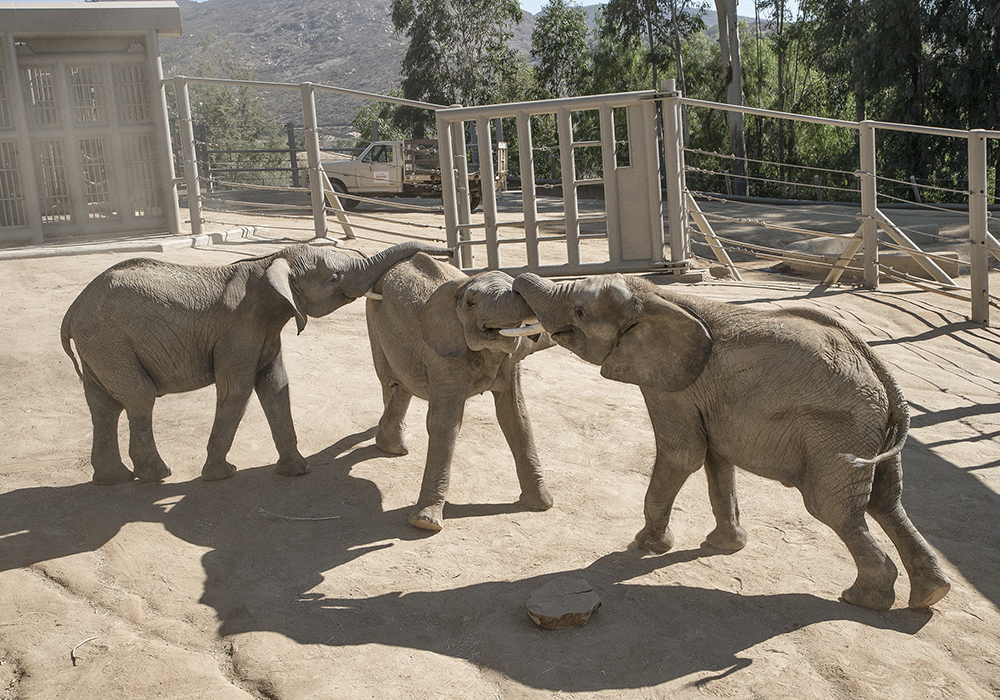
BOYS WILL BE BOYS
All born at the Safari Park, young males Emanti, Ingadze, and Inhlonipho frolic.
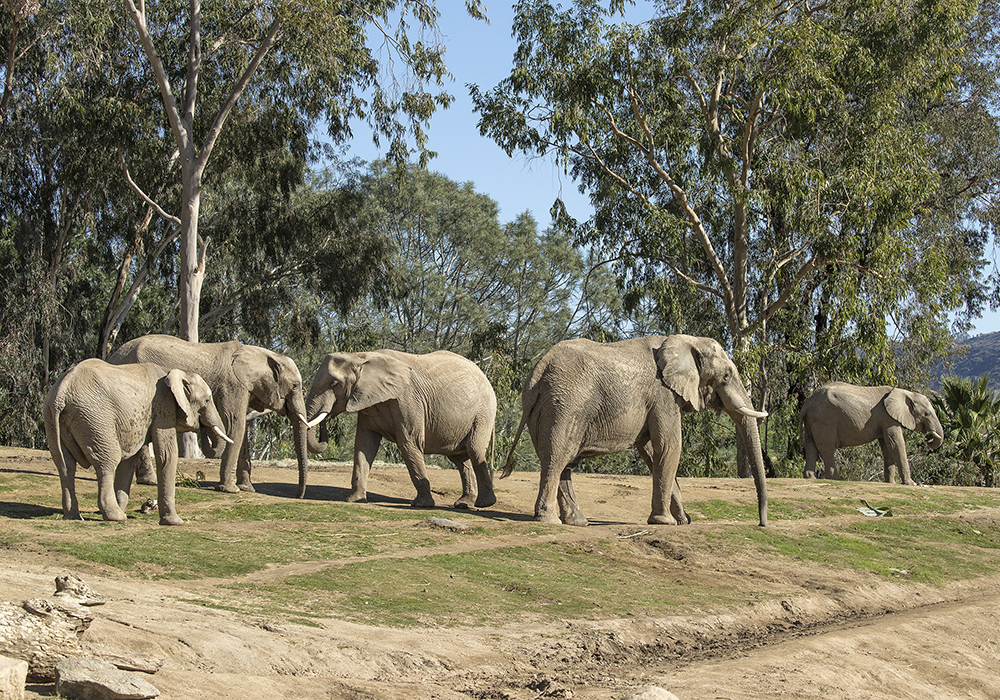
THE CALVES KEEP COMING
Elephants eMacembe (left), Khosi (second to left), and Ingadze (right)—along with five of their herd-mates—were all born at the Safari Park. Here they socialize with adult female Umngani (center) and bull M’sholo. Later this year, they’ll be joined by two more calves.
According to Barbara, female elephants are most successful at getting pregnant and bearing a calf between the ages of about 15 and 35, so our females are at their prime, reproductively. And bulls are intently in tune with female estrus and time of ovulation, detecting pheromones with their keen sense of smell. “Even with all our technology and science, we can’t come close the accuracy of the the nose of a bull,” says Barbara.
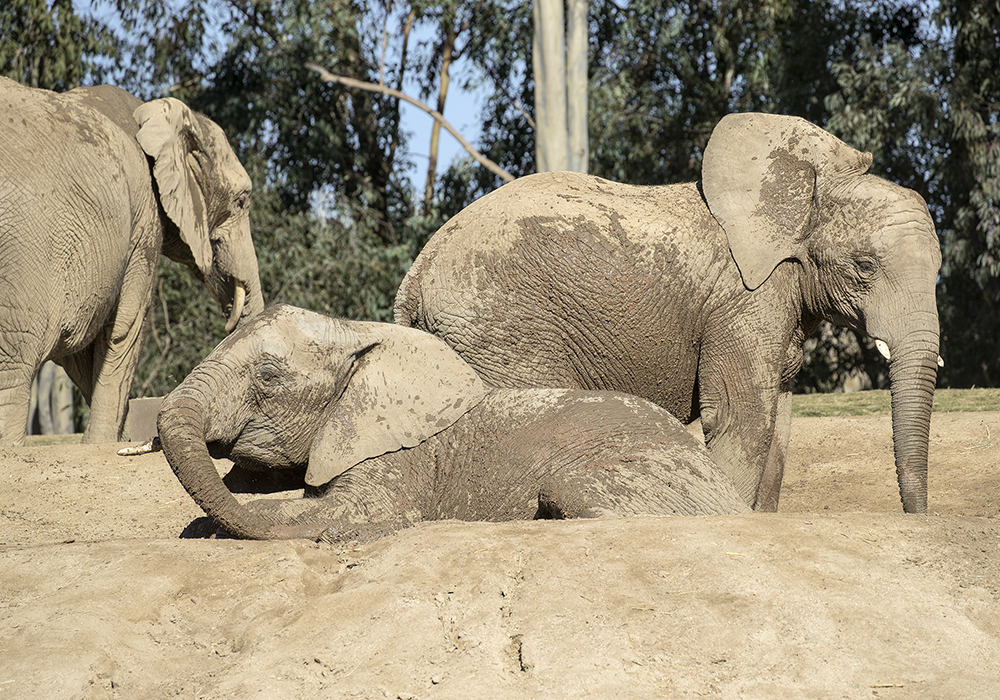
SHEER MUDNESS
Keepers create pools and mud wallows to provide environmental enrichment and encourage natural elephant behaviors.
BEHIND THE SCENES
At the Safari Park, elephant keepers arrive early to plan their day, prepare elephant diets, place enrichment opportunities, and shift the elephants. And when that’s done, there’s poop (and lots of it—two truckloads!) to be scooped. “Our day is nonstop,” says Curtis. “We have such a dedicated, hard-working team.”
With the enrichment, social interaction, and shared space that the team provides, they seem to have found the key to a happy herd of elephants.
MEET THE HERD

TEAM SWAZI
From left: Macembe, Swazi, and Qinisa
Swazi
Matriarch Swazi arrived at the Safari Park as an adult. Mother to eMacembe and Qinisa, she was the last of our Swaziland female elephants to reproduce.
eMacembe LaLu Hlata
Swazi’s first calf, male Macembe (muh-COM-bay) was born in 2010. His full name is SiSwati for “green leaves.”
Qinisa
Qinisa is SiSwati for “to act with energy” or “to speak the truth.” The “Q” is properly pronounced as a tongue pop (!), but her keepers call the little elephant “keen-EE-seh.” Currently the youngest in the herd, she was born in 2012.
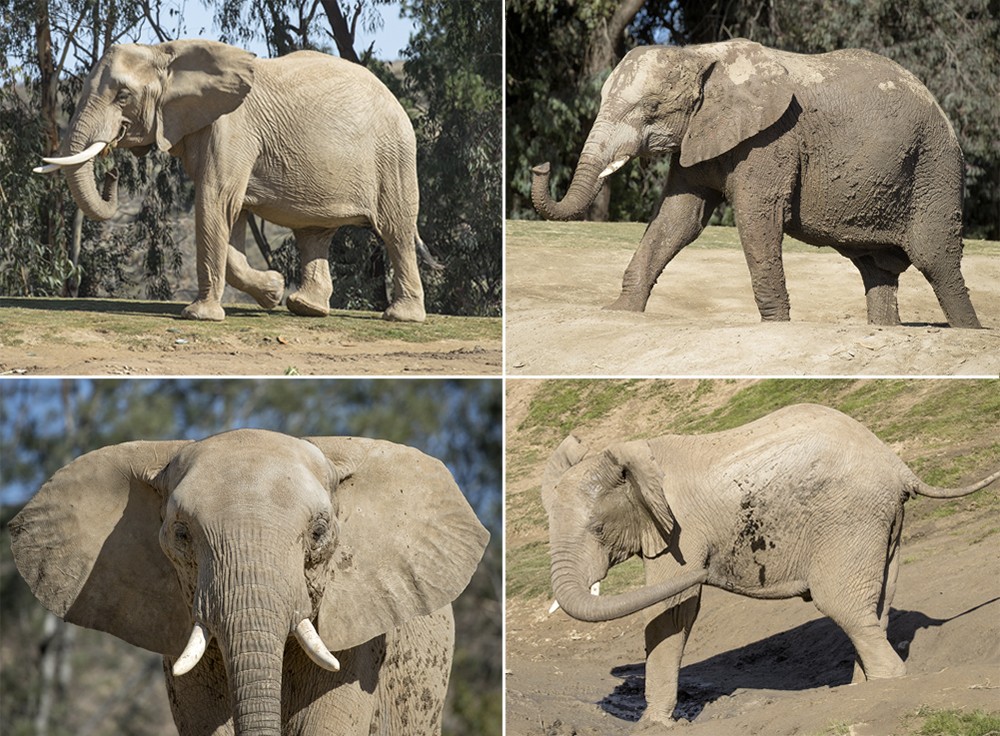
TEAM UMNGANI
Clockwise from top left: Umngani, Khosi, Inhlonipho, and Ingadze
Umngani
Adult female Umngani (OOM-gah-nee), who came to the Safari Park as an adult, is mother to three calves, and pregnant with a fourth. Her name means “friend,” in SiSwati, accurately reflecting her sweet-natured personality.
Khosi
Umngani’s first calf was the first of the Swaziland calves conceived and born at the Safari Park. Born in 2006, female Khosi (KO-see) has recently reached reproductive age.
Ingadze
Gadze (GAD-zee) is Umngani’s second calf, a male born in 2009. His name is SiSwati for “garden.”
Inhlonipho
“Neepo” is Umngani’s third calf, born in 2011. His full name is SiSwati for “respect,” “honor,” or “good manners”—but it’s a mouthful. Hence the nickname.
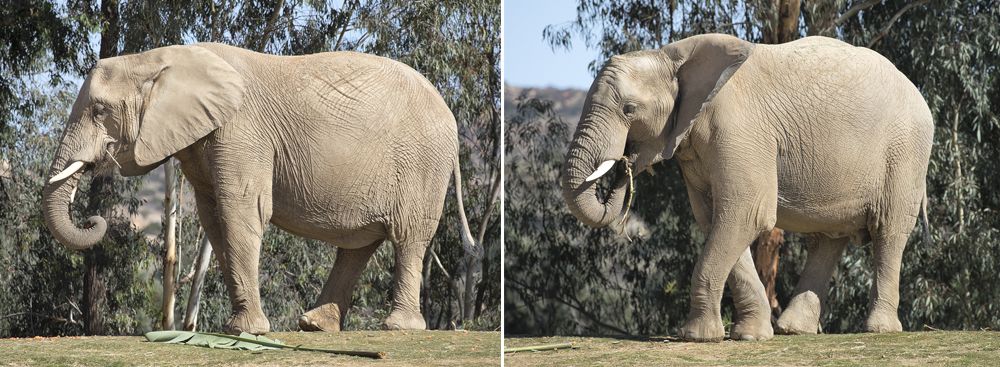
NDULA AND SON
From left: Ndula and Luti
Ndulamitsi
Ndula (en-DOO-luh) came to the Safari park as an adult—a pregnant one! She gave birth to a male calf, Vus’musi, (voos-MOO-see), currently on loan to the Fresno Chaffee Zoo. She is also the mother of Lutsandvo.
Lutsandvo
Luti (LOO-dee) is Ndula’s second calf. In 2010, he was the first calf born out in the main elephant yard, with the rest of the herd present. His full name is SiSwati for “love.”
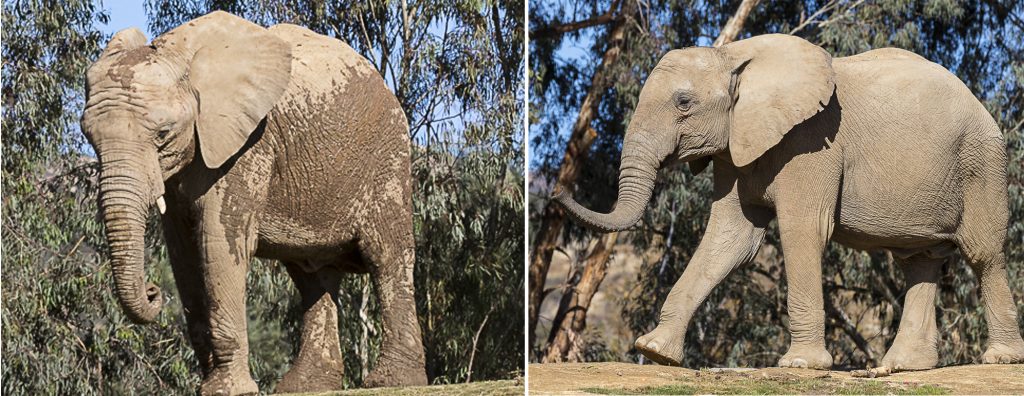
BROTHER AND SISTER
From left: Kami and Emanti
Phakamile
Better known as “Kami,” this female elephant was born in 2007, but for an elephant, she’s a teenager. Kami has a younger brother, Emanti. Her full name is SiSwati for “noble strength.”
Emanti
The younger brother of Kami, Emanti (ee-MAHN-tee) was born in the main elephant yard in 2010. His name, SiSwati for “water,” was selected in an online naming poll.
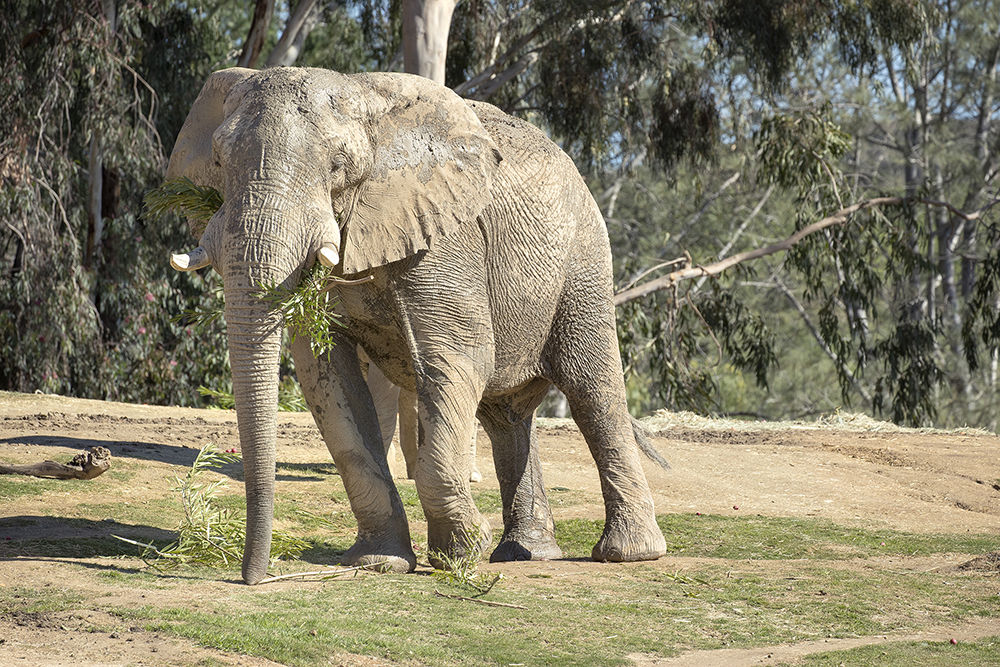
THE BIG BULL
M’sholo
M’sholo
M’sholo, another elephant rescued from a scheduled cull, is a bull on loan from Lowry Park Zoo in Tampa, Florida. His name comes from the SiSwati for “appears from nowhere.”

